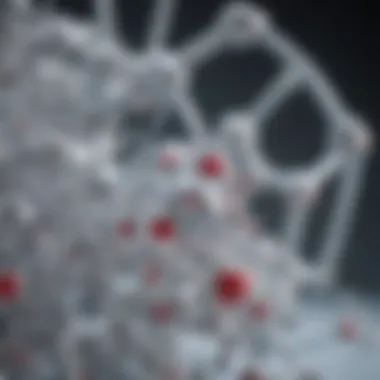Understanding Dioxolane: Chemical Properties & Uses


Intro
Dioxolane is a cyclic ether which has gained attention in various chemical and industrial sectors. This compound, characterized by its unique molecular structure, plays an important role as a solvent and can also be found in several pharmaceutical applications. The study of dioxolane encompasses its detailed chemical properties, various synthesis methods, and its practical applications. Understanding these facets not only sheds light on its significance but also highlights safety concerns and environmental impacts.
Key Findings
Summary of the main results
Dioxolane demonstrates a range of chemical properties that make it suitable for multiple uses. It has a low boiling point and presents good solvent capabilities, particularly for polar and non-polar substances alike. The results from various studies indicate that dioxolane exhibits moderate toxicity, emphasizing the need for caution during handling.
Significance of findings within the scientific community
The significance of dioxolane in research cannot be overstated. Its relevance as a solvent in chemical reactions is backed by empirical data. Researchers often prefer dioxolane due to its high dielectric constant, which promotes better solubility for a vast collection of compounds. Moreover, studies show that dioxolane is crucial in the synthesis of important intermediates in drug development, linking it to the pharmaceutical field.
Applications in Real-World Scenarios
Dioxolane is applied in various practical scenarios:
- Solvent: It's widely used as a solvent in chemical laboratories for reactions requiring polar solvents.
- Industrial Uses: Dioxolane finds its place in the production of certain polymers, enhancing the properties of plastic products.
- Pharmaceuticals: Its role in drug formulation is vital, particularly for enhancing the solubility of active substances.
Potential impact on future research directions
Research into dioxolane encourages the exploration of safer and more effective solvents in various applications. Additionally, further studies focusing on its environmental impact and potential alternatives can shape future practices within the industry.
Dioxolane's application potential stretches beyond its current uses, suggesting new pathways for innovation in both research and industry.
Closure
In summary, dioxolane stands as an important chemical in the field of science and industry. Its properties make it a versatile compound for various applications, fulfilling a significant role in laboratories and pharmaceuticals alike. Awareness of its chemical behaviors, synthesis methods, and safety concerns is essential for those engaged in scientific research and the industrial sector.
Prelims to Dioxolane
Dioxolane is a significant compound in both chemical research and various industrial applications. Understanding its properties and uses is crucial for students, researchers, and professionals engaged in chemistry and related fields. Dioxolane, as a cyclic ether, serves multiple roles including being a solvent and a starting material in organic synthesis. This compound has distinct characteristics that enhance its utility in various applications. Recognizing these attributes helps in exploring further innovations in chemistry and materials science.
Definition and Basic Characteristics
Dioxolane, chemically known as 1,3-dioxolane, is a five-membered ring compound featuring two oxygen atoms and three carbon atoms. Its molecular formula is C3H6O2. This structure grants dioxolane properties that are beneficial in many settings.
Dioxolane is colorless and has a somewhat sweet odor. Its boiling point is approximately 101 °C, making it suitable for various thermal applications. Another important point is its density, which is lower than water. Its solubility in organic solvents further establishes its versatility. Dioxolane's basic characteristics make it attractive for sectors that require solvents with specific thermal and chemical stabilities.
Historical Context
The history of dioxolane dates back to the early 20th century when chemists began to explore cyclic ethers. Its relevance increased during the development of organic synthesis techniques. Initially, dioxolane was of interest primarily for its unique structural properties. Over the decades, as the demand in pharmaceuticals and fine chemical production grew, so did interest in dioxolane's applications.
In particular, during the 1970s, dioxolane became more prominent as industries were seeking alternatives for traditional solvents like ether compounds. Its low toxicity profile and favorable boiling point contributed to its adoption in various formulations. Today, researchers are continually exploring new applications for dioxolane, shedding light on its potential across several disciplines.
"Dioxolane stands as an example of how a chemical compound can evolve in significance with advancements in research and technology."
Understanding dioxolane requires an appreciation of both its fundamental qualities and the historical developments that have shaped its applications. Each aspect invites researchers to examine its impact and roles in contemporary scientific environments.
Chemical Structure of Dioxolane
The chemical structure of dioxolane plays a critical role in its properties and applications. Understanding this structure aids in deciphering its behavior in various chemical reactions and interactions. Dioxolane, as a cyclic ether, is characterized by its unique ring structure, which includes two oxygen atoms within a five-membered ring. This configuration offers several benefits, including increased stability and lower reactivity compared to linear structures. Dioxolane's versatility is further highlighted by its functional capabilities, making it a sought-after compound in organic synthesis and material science.
Molecular Formula


Dioxolane possesses a molecular formula of C₄H₈O₂. This simple yet effective composition underscores its utility in many applications. The ratio of carbon to hydrogen and oxygen is crucial for establishing the intermolecular forces that govern its solubility and reactivity. Dioxolane's formula indicates that it has two oxygen atoms, which contribute significantly to its polarity. This attribute enhances its ability to dissolve various organic and inorganic compounds, making dioxolane a valuable solvent in laboratory settings and an intermediate in chemical reactions.
Isomeric Forms
Dioxolane, like many organic compounds, can exist in different isomeric forms. These isomers arise due to variations in the arrangement of atoms within the molecule, leading to distinct physical and chemical properties. The most common isomer of dioxolane is the 1,3-dioxolane, where the two oxygen atoms are separated by one carbon atom in the ring structure. Other potential isomers may include different arrangements of substituents or variations in the ring size.
It is essential to recognize that isomeric forms can exhibit different behaviors in chemical reactions, which can influence the selection of a compound for specific applications.
Isomers can also impact the synthesis pathways of dioxolane derivatives. Understanding the implications of these variations is crucial for researchers and industry professionals who work with this compound. By examining dioxolane's molecular structure and its isomeric forms, one gains valuable insights into its functionality and potential uses in various fields, including pharmaceuticals and agrochemicals.
Physical Properties of Dioxolane
Understanding the physical properties of dioxolane is crucial for various applications in both chemical research and industry. These properties influence how dioxolane behaves in different environments and its interactions with other substances. Dioxolane’s utility as a solvent, particularly in organic synthesis, heavily relies on its boiling point, melting point, density, solubility, and refractive index. Each element of its physical characteristics plays a role in determining its effectiveness for specific applications.
Boiling and Melting Points
The boiling point of dioxolane is around 103 °C, while its melting point is approximately -60 °C. These temperature thresholds indicate that dioxolane remains in liquid form under common laboratory conditions, making it a suitable solvent for various reactions. Its moderate boiling point allows for effective solvent evaporation when needed, without decomposing sensitive reactants. Conversely, the low melting point facilitates easy handling at slightly elevated temperatures. Understanding these points helps chemists optimize reaction conditions and manage processes more effectively.
Density and Solubility
Dioxolane has a density of about 1.06 g/cm³, classifying it as a moderately dense liquid. This property is significant for calculations regarding weight and volume in laboratory setups. Dioxolane is also notable for its solubility in water and various organic solvents such as ethanol and acetone. Its miscibility with both polar and non-polar solvents enhances its appeal as a medium for a wide range of chemical reactions. This solubility profile informs researchers about how best to use dioxolane in diverse synthesis scenarios.
Refractive Index
The refractive index of dioxolane is approximately 1.43. This value indicates how light propagates through the substance, an important factor in applications that require precise optical measurements. The refractive index can influence the outcomes of reactions that involve light-sensitive materials. In analytical chemistry, understanding light behavior in dioxolane could enhance techniques like spectroscopy, facilitating the identification and quantification of various compounds.
The physical properties of dioxolane position it as a versatile tool in both research and practical applications, ensuring effective interaction with a variety of chemical substances.
The importance of these physical properties should not be underestimated; they are foundational to the successful application of dioxolane in areas ranging from organic synthesis to pharmaceuticals. By grasping these fundamental characteristics, professionals and students can better appreciate the functional role that dioxolane plays in the intricate landscape of chemical sciences.
Synthesis of Dioxolane
The synthesis of dioxolane plays a pivotal role in understanding its applications and benefits. This cyclic ether serves various purposes, particularly in chemical reactions where its structure can offer specific advantages. Understanding the synthesis methods allows researchers and industrial chemists to optimize production processes. Briefly examining these methods also helps in assessing the efficiency and safety of dioxolane's production.
Common Synthesis Methods
Several established methods for synthesizing dioxolane exist, each with unique implications for purity and yield. One of the common methods is the reaction between 1,3-dioxolane and various aldehydes. This process can often yield high purity dioxolane when conducted under controlled conditions.
In addition to the reaction with aldehydes, dioxolane can also be synthesized through the treatment of glycol with an appropriate acid catalyst. This method allows a relatively simple setup and can be adapted for varying scales of production.
- Sodium hydride and a suitable solvent: This method generates dioxolane in good yield and has been employed widely in organic synthesis, especially in laboratory settings.
- Dehydration of glycols: By eliminating water from glycols under certain conditions, dioxolanes can be produced effectively, although this method requires careful temperature control to avoid side reactions.
Each of these methods has distinct benefits. For example, the acid-catalyzed dehydration tends to simplify the purification process due to a fewer number of by-products. Yet, considerations must be made regarding the environmental impact of by-products and how they are managed post-synthesis.
Catalytic Processes
The utilization of catalytic processes in dioxolane synthesis is noteworthy and warrants exploration. Catalysts can significantly enhance the efficiency of the reactions involved in dioxolane formation. A popular catalytic route involves using solid acid catalysts, such as zeolites, which are particularly effective for the chemical transformation.
These catalysts can reduce the energy required during synthesis, enhancing sustainability. They also help in minimizing the production of unwanted by-products, which is crucial for maintaining high purity in the final product.
Solid acid catalysts permit the production of dioxolane with high selectivity, making them favorable for eco-friendly chemical processes.
We can also observe trends towards using biocatalysts for synthesizing dioxolane. This newer approach represents a conscious shift towards greener practices in chemical synthesis. Biocatalysts offer the potential for mild conditions or lower environmental impact, which aligns with the growing demands for sustainable chemical processes.
In summary, the synthesis of dioxolane encompasses various methods, from traditional reagents to advanced catalytic approaches. Each method contributes to the growing understanding of dioxolane, its usability, and the need to consider both efficacy and environmental impact. Such comprehension not only benefits research but also influences industrial applications where dioxolane is utilized.


Applications of Dioxolane
Dioxolane serves an essential role in both industrial and laboratory settings due to its unique properties. Understanding these applications is vital, as they reflect the chemical's versatility and underline its significance in various fields. This section will explore the diverse uses of dioxolane, highlighting its benefits and associated considerations.
Use as a Solvent
Dioxolane is widely recognized for its effectiveness as a solvent. Its ability to dissolve a variety of organic compounds makes it a valuable tool in both research and industrial applications. Unlike many polar solvents, dioxolane displays a unique balance between polarity and stability, allowing it to enhance reactions without significantly affecting them.
The solvent's low boiling point facilitates easy evaporation, which can prove advantageous in laboratory settings. Furthermore, its relatively high dielectric constant provides improved solvation for ions, making it ideal for certain electrochemical processes.
In practical terms, dioxolane can be used in various chemical reactions, including polymerization and extraction procedures. Researchers often select it for its compatibility with sensitive reagents, which ensures reaction fidelity. However, it is crucial to handle this chemical with care due to its potential health risks, which will be further discussed in the safety sections.
Role in Organic Synthesis
In organic synthesis, dioxolane plays a noteworthy role. It acts as a precursor for several organic compounds and participates in key reactions, providing an effective medium for complex transformations. This cyclical ether facilitates reactions such as nucleophilic substitutions and cyclizations, enabling chemists to create desirable molecular architectures.
The structure of dioxolane allows it to participate in reactions without being significantly consumed, thus maximizing efficiency. Many synthetic pathways utilize dioxolane for building more intricate molecules, making it integral in the development of pharmaceuticals and other fine chemicals.
The importance of dioxolane in organic chemistry can be attributed to its unique interactions with a variety of reagents, enhancing reaction outcomes. Elevated yields and improved selectivity often result from its use, establishing it as an indispensable solvent in synthetic procedures.
Pharmaceutical Applications
The pharmaceutical industry appreciates dioxolane for its solvent properties in drug formulation. Its ability to dissolve numerous compounds, including active pharmaceutical ingredients, enables formulators to create stable and effective products. Moreover, dioxolane's chemical stability and low toxicity profile make it an attractive candidate for drug delivery systems.
Research has shown that utilizing dioxolane in formulations can lead to enhanced bioavailability of poorly soluble drugs. This characteristic allows pharmaceutical scientists to improve the efficacy of medications and optimize therapeutic outcomes.
Additionally, dioxolane features in the production of intermediates for various pharmaceuticals. Its role as a protective solvent in certain reactions helps prevent degradation or side reactions, leading to higher purity in final products. This compound has shown promise in creating more effective pharmaceutical agents, further establishing its significance in drug development.
Potential in Agrochemicals
The agrochemical sector also benefits from dioxolane's properties. It appears as a solvent and enhancing agent in pesticide formulations, where it helps improve the bioactivity of active ingredients. Dioxolane's ability to influence the solubility and dispersibility of substances aids farmers by providing more effective application methods.
As agriculture evolves with a focus on higher efficiency and less environmental impact, dioxolane could offer solutions that align with this goal. By ensuring better absorption and reduced runoff, its use in agrochemicals could improve sustainability in agricultural practices.
Moreover, ongoing research into dioxolane's interactions with various agrochemical compounds may unlock further potential applications in the enhancement of crop protection technologies. Its role in improving the effectiveness of pesticides highlights its importance in fostering sustainable agricultural solutions.
Dioxolane's versatility as a solvent is instrumental in its wide-ranging applications across various fields, including pharmaceuticals and agrochemicals.
In summary, dioxolane holds significant importance in several domains. Its use as a solvent, participant in organic synthesis, and critical role in pharmaceuticals and agrochemicals reinforces its value in scientific research and industrial applications. Understanding these applications informs ongoing discussions about safety, effectiveness, and environmental considerations.
Safety and Environmental Concerns
The safety and environmental concerns surrounding dioxolane are crucial in assessing its viability for various applications. As industries increasingly prioritize sustainability and chemical safety, understanding the potential hazards of dioxolane becomes essential. This section delves into the toxicological profile of dioxolane and its environmental impact, highlighting the significance of these aspects for researchers and professionals.
Toxicological Profile
Dioxolane possesses a unique toxicological profile that warrants careful examination. It is generally regarded as having low acute toxicity. However, exposure routes such as inhalation, skin contact, and ingestion must be monitored. Prolonged exposure to dioxolane can lead to irritations and adverse health effects.
- Symptoms of Exposure: Individuals exposed to dioxolane may experience symptoms like headaches, dizziness, and respiratory irritation.
- Regulatory Framework: Agencies such as the Occupational Safety and Health Administration (OSHA) and the Environmental Protection Agency (EPA) have set guidelines to mitigate exposure risks.
A more detailed understanding of dioxolane's composition can aid in managing its use safely. Current research focuses on its interaction with biological systems, offering insights that inform necessary safety precautions in relevant industries.
Environmental Impact
The environmental impact of dioxolane cannot be overlooked. As a solvent and intermediate in chemical processes, its release into the environment poses potential risks. Evaluating these impacts contributes to responsible industrial practices.


- Biodegradability: Dioxolane is biodegradable under certain conditions, though the extent and speed of degradation can vary based on environmental factors.
- Aquatic Toxicity: Studies indicate that dioxolane resembles other organic solvents, suggesting that it may have harmful effects on aquatic life if released improperly.
- Soil and Water Contamination: Contamination of soil and groundwater remains a concern. Containment measures must be implemented during storage and use.
The need for stringent regulations regarding the handling and disposal of dioxolane is paramount for the safety of both human health and the environment.
Regulatory Status of Dioxolane
The regulatory status of dioxolane is crucial because it governs how this compound is handled in various industries. Understanding the regulations helps ensure safe use, environmental protection, and compliance with legal standards. Dioxolane, a cyclic ether, falls under different regulatory frameworks that can vary depending on the region. This section looks closely at international guidelines and industry compliance.
International Guidelines and Standards
Multiple organizations outline the guidelines for the use of dioxolane. One prominent body is the Occupational Safety and Health Administration (OSHA) in the United States, which sets permissible exposure limits (PEL) to ensure worker safety. Another important entity is the Environmental Protection Agency (EPA), which evaluates the environmental impact of substances like dioxolane. The EPA may categorize it under different classifications which affects how manufacturers and users must treat it.
Additionally, organizations like the European Chemicals Agency (ECHA) provide Safety Data Sheets (SDS) that convey hazards, storage, and disposal methods. These guidelines ensure that dioxolane is managed effectively, minimizing potential risks to health and the environment.
Compliance in Industry
Industry compliance with the regulatory status of dioxolane is paramount. Companies that use dioxolane in processes must ensure that they follow the established guidelines. Failure to comply can result in penalties, product recalls, or damage to reputation.
- Training and Education: Employees must be trained on the proper handling of dioxolane and aware of the potential hazards associated with it.
- Monitoring Usage: Regular monitoring should be in place to assess exposure levels and ensure they remain within legal limits.
- Record Keeping: Detailed records on the purchase, use, and disposal of dioxolane ensure transparency and accountability.
- Risk Assessment: Companies must conduct risk assessments to identify any potential hazards associated with dioxolane use and take steps to mitigate these risks.
By adhering to these standards, industries that utilize dioxolane can maintain a safe environment for their workers and minimize negative impacts on health and the environment.
"Understanding the regulatory framework is not just about compliance; it is about ensuring the safety of both workers and the environment."
In summary, the regulatory status of dioxolane encompasses a wide range of guidelines and compliance protocols. These efforts are essential in making sure that the compound is used responsibly in various applications.
Future Directions in Dioxolane Research
Research on dioxolane is poised for significant advancements, driven by its multifaceted applications in various scientific fields. Exploring future directions in dioxolane research is crucial for tapping into its potential benefits and discovering novel uses. This section delves into emerging applications and trends that may define the future landscape of dioxolane.
Novel Applications
The exploration of novel applications for dioxolane is a key area of research. Its unique chemical properties make it a strong candidate for several purposes that have yet to be fully realized. For example, its low toxicity and high dielectric constant could make it suitable for new types of battery electrolytes, providing an alternative to traditional solvents used in energy storage systems. Researchers are investigating its use as a medium for electrochemical reactions, which could enhance efficiency in various industrial processes.
In addition to energy applications, dioxolane's stability and solubility characteristics make it attractive for pharmaceutical formulations. Its role as a solvent in drug delivery systems is under exploration, potentially improving the bioavailability of poorly soluble drugs. This avenue aligns with growing demands in medicinal chemistry, aiming to develop more effective therapeutics.
Furthermore, agricultural research is beginning to examine dioxolane's utility as a carrier for agrochemicals. Its ability to dissolve various substances efficiently can facilitate targeted delivery, enhancing the performance of pesticides and fertilizers while minimizing environmental impact.
Research Trends
Current research trends focus on sustainability and efficiency in chemical processes involving dioxolane. Chemists are prioritizing greener synthesis methods, aiming to reduce waste and energy consumption in production. This shift is not merely regulatory but a commitment to fostering environmentally responsible practices in chemical manufacturing.
The integration of dioxolane in green chemistry and its application in sustainable materials development is another trend gaining momentum. This includes studies on biodegradable polymers that utilize dioxolane as a solvent or co-solvent during the production processes. Research shows promise in using dioxolane to improve the properties of biopolymers, which is very important in reducing plastic waste.
Moreover, interdisciplinary approaches are becoming more prominent. Collaborations between chemists, materials scientists, and engineers aim to innovate systems that utilize dioxolane across different sectors. By engaging various academic fields, researchers can better gauge the compound's diverse applications and bring forth more innovative solutions to current challenges.
Conclusion: The evolution of dioxolane research holds significant promise. As scientists uncover novel applications and pursue sustainable practices, dioxolane could transform various industrial and research arenas.
Finale
The conclusion of this article serves as a critical reflection on the essential elements surrounding dioxolane, particularly its chemical properties and practical applications. Recognizing the importance of dioxolane is fundamental not only for academic purposes, but also for industries relying on its diverse functions. As a cyclic ether, its unique structure influences various properties that dictate usage in many fields.
Summary of Key Points
Dioxolane is a compound characterized by its distinct molecular structure, exhibiting properties that facilitate its role as a solvent and a reagent. Key points from this discussion include:
- Chemical Structure: Dioxolane is understood through its molecular formula, highlighting the presence of oxygen atoms in its ring structure.
- Physical Properties: The compound's boiling and melting points contribute to its usability in different applications, while factors like density and solubility impact its integration in various processes.
- Synthesis Methods: Several methods, including catalytic processes, showcase how dioxolane is produced, emphasizing efficiency and yield in laboratory settings.
- Applications: Its versatility is apparent through its roles in pharmaceuticals, organic synthesis, and potential agrochemical innovations.
- Safety and Environmental Considerations: The article also highlighted the toxicological and environmental aspects tied to dioxolane, necessitating careful handling and regulatory compliance.
Significance in Scientific Discourse
Dioxolane plays an influential role in the scientific community. Its relevance spans multiple disciplines, from chemistry to environmental science and pharmaceuticals. The ongoing research and findings surrounding this compound enrich the existing body of knowledge, driving innovation and safety measures within industrial applications. The conversation about dioxolane also prompts other researchers to explore potential new applications, ensuring that the material remains at the forefront of scientific inquiry. By fostering awareness and understanding of dioxolane, this article aims not just to inform, but also to encourage further exploration into its broader implications.







